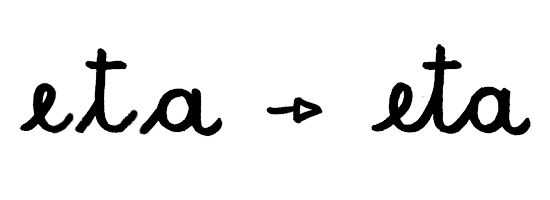Basic Structure
We asked a large number of teachers in Italian elementary schools to send us the model they currently use to teach cursive handwriting. They all sent us models similar to the one in Figure 5.
In this model, the entrance strokes of letters such as a, e, i, duplicates the exit strokes of the preceding letter, thereby causing considerable confusion. We should ask ourselves about the entrance and the exit stroke: is it a joining segment or a decorative flourish? If it is a flourish, it is unnecessary; if it is a join, what is it doing at the beginning of a word ?
To write this cursive model, children have to play a guessing game. For example, the letter joining mechanisms are not explained to them. If e and t come next to each other, certain elements are duplicated. (Figure 6.) .
Let’s examine a Copperplate capital, for example the H (Figure 3.): The shape is very complicated, hard to remember and so difficult to read that a little crossbar in the middle of the letter is added to avoid confusing with the Italian article Il. Italic-style cursive has none of these archaic forms with all their unnecessary, hard-to-remember flourishes. Instead, simple, Roman-style capitals are used.
This old-fashioned model, which is still being taught, makes it more difficult for children to learn cursive. Many children opt for capitals which are slower but much easier to write and are more legible.







